A retrospective look at the research on dyscalculia
from a bibliometric approach1
Una mirada retrospectiva a la investigación en discalculia desde una aproximación bibliométrica
DOI: 10.4438/1988-592X-RE-2022-396-535
Estefanía Espina
José M. Marbán
Ana Maroto
Universidad de Valladolid
Abstract
Dyscalculia is a learning disorder that affects the correct acquisition of arithmetic skills and significantly influences both the daily life of students and their academic success. Being a disorder with an estimated prevalence between 2.27% and 6.4%, it has received much less attention than others, such as dyslexia or attention-deficit/hyperactivity disorder (ADHD). This study, based on a methodological design of the mapping of science and from a bibliometric approach, allows for the visualization of the scientific literature on dyscalculia present in the Web of Science (WoS) and Scopus databases, dimensioning the research carried out from the moment the term dyscalculia was used for the first time to the present and analyzing the evolution of scientific literature on this subject and how it has been organized and structured. The collected publications have been analyzed with the support of the VOSviewer program and a bibliographic coupling analysis between countries has been carried out as well as word co-occurrence analysis and the citation of sources and publications. Results indicate that over the past few years, the scientific community has shown a growing interest in in dyscalculia, strongly localized in a small group of countries, and a predominance of contributions focused on understanding the disorder and in its diagnosis, yet there is still a great need for research that provides solid evidence for educational intervention aimed at the full inclusion of students with dyscalculia, beyond proposals for the design of support resources, especially technological ones.
Key words: bibliometrics, scientific production, dyscalculia, learning difficulty, mathematics education, learning disability.
Resumen
La discalculia es un trastorno del aprendizaje que afecta a la correcta adquisición de las habilidades aritméticas y que puede llegar a influir significativamente tanto en la vida cotidiana del alumnado como en su trayectoria académica. Siendo un trastorno con una prevalencia estimada entre el 2,27% y el 6,4%, ha recibido mucha menos atención que otros como, por ejemplo, la dislexia o el Trastorno por Déficit de Atención e Hiperactividad (TDAH). Este estudio, a partir de un diseño metodológico propio del mapeo de la ciencia y desde una aproximación bibliométrica, permite visualizar la producción científica sobre discalculia presente en las bases de datos Web of Science (WoS) y Scopus, abordando la investigación realizada desde que el término discalculia fue empleado por primera vez hasta nuestros días y analizando cómo ha evolucionado y cómo se organiza y estructura la literatura científica sobre esta temática. Las publicaciones recolectadas han sido analizadas con apoyo del programa VOSviewer y se han efectuado análisis de acoplamiento bibliográfico de países, de citación de fuentes y publicaciones y de co-ocurrencia de palabras. Los resultados muestran un creciente interés de la comunidad científica por la discalculia en los últimos años, fuertemente localizado en un grupo reducido de países y un predominio de las contribuciones centradas en la comprensión del trastorno y en su diagnóstico, adoleciendo aún de investigaciones que aporten sólidas evidencias para la intervención educativa orientada a la inclusión plena del alumnado con discalculia, más allá de propuestas de diseño de recursos de apoyo, sobre todo tecnológicos.
Palabras clave: bibliometría, producción científica, discalculia, dificultad de aprendizaje, educación matemática, trastorno de aprendizaje.
Introduction
Learning difficulties in mathematics create a huge obstacle to becoming fully literate in mathematics learning, understood in its dual role as a language and also as a key to understanding the world around us. Mathematics is the key to understanding a huge quantity of information that we receive on a daily basis, which is largely numerical, and crucial to resolving problems. The origin of the term learning disabilities (LDs) has a long history, which, on an international level, can be divided in five time periods (Hallahan and Mercer, 2002). The first corresponds to the European Foundation Period (1800-1920), centering on neurological discoveries related to speech and literacy skills. The second, is the U.S. Foundation Period (1920-1960), when the development of tests and intervention methods was the focus. In the third period (1960-1975), LDs were first formally recognized by definition and categorized. Then, in 1962, Kirk and Bateman (1962) coined the term learning disabilities for the first time, referring to a retardation, disorder, or delayed development, caused by possible cerebral dysfunctions or emotional or behavioral disorders in reading, writing, language, mathematic processes, or in other scholastic subjects. The fourth period (1975-1985) refers to a relatively stable time in comparison to the previous periods and is marked by reaching consensus not only on the concept and definition of LDs but also on diagnostic methods. Lastly, in the period leading up to the present, different institutions like the National Joint Committee on Learning Disabilities (NJCLD), the American Psychiatric Association (APA), and the World Health Organization (WHO) have consolidated the definitions and classifications of LDs. In this way, the most recent definition of LDs, published in the fifth edition of the Diagnostic and Statistical Manual of Mental Disorders (APA, 2013), considers them neurological developmental disorders that impede learning capacity or the ability to learn specific foundational academic skills (for example, reading, writing, or mathematics). In the latest version of the International Classification of Diseases (IDC-11, 2020), developed by the World Health Organization (WHO) and to be implemented starting January 1st, 2022, learning disabilities fall under the category “6A03 Developmental Learning Disorder.”
Focusing on the national level, Spain affirmed people with disabilities’ rights to integration and education in the Law of Social Integration of the Disabled (1982) and, more concretely, in the Royal Decree (334/1985) on the organization of Special Education. While Learning Disabilities have no concrete definition, they are integrated into a wider category of Special Educative Needs (NEE) (Coronado-Hijón, 2008). According to the Law of General Organization of the Educational System (LOGSE, 1990) the adaptation of teaching/learning to the characteristics of students with or without special needs must be made available, and, furthermore, in the Organic Law of Education (LOE, 2006), and the Organic Law on Improvement of Educational Quality (LOMCE, 2013) students with learning disabilities are included within the category of those with Specific Learning Disabilities (SLDs). Nowadays, the Organic Law Project, which modifies the LOE and was published November 25th, 2020, ascertains that “school centers must have the resources necessary to attend to all disabled students in the best conditions” (p.69).
Regarding scientific publications on LDs, those which include research on dyslexia or ADHD are much more prevalent than those on dyscalculia (Kaufmann et al., 2013 and May and Ahmad, 2020), despite the fact that dyscalculia can be found in 2.27% to 6.4% of the scholastic population (Estévez et al., 2008). Dyscalculia is a specific neurobiological learning disorder caused by abnormalities in the cerebral structures behind numeric representation and information processing (Butterworth et al., 2011). It is likely to have genetic origins, as children with family members suffering from dyscalculia have been found to be at higher risk of suffering from this disorder. Dyscalculia interrupts the correct acquisition of mathematic skills and significantly interferes with academic performance and everyday activities related to mathematics or those that require the use of such. It is an “unexpected” disorder as it can be found in children who have completely normal intelligence levels and otherwise appropriate scholastic development (Sans et al. 2012). Furthermore, dyscalculia presents in a heterogeneous way, yet children with dyscalculia experience difficulties with the most basic aspects of numeric processing and calculation in general. As such, these children could have a poor sense of numbers or quantities, may experience problems with identification, counting, reading, writing and/or classification of numbers and are likely to have trouble with completing arithmetic or mathematical problems (Fonseca et al., 2019). Moreover, although dyscalculia can appear on its own, one forth of children affected by dyscalculia show tendencies for other disorders like ADHD, dyslexia, language disorders, anxiety, etc.
The main motivation behind this research is the fact that dyscalculia is generally unknown to society nowadays (Arroyo, 2018) and is rarely included in scientific literature in comparison to other learning challenges or disorders (Torresi, 2018 and Haberstroh and Schulte-Körne, 2019). The main objective of this paper is to visualize all the scientific activity to date regarding dyscalculia in order to identify ideas, tendencies, and inherent structures of the state of the question of this disorder, which in turn, aids in decision making related to its treatment from both a research standpoint as well as an organizational and political standpoint on what actions to take by those responsible for the field of education.
In this context, the theoretical framework for the current study is essentially based on Shneider (2009) and his theory on the evolution of the scientific discipline. His theory states that there are four stages to the evolution. The first one outlines the problem, identifying important questions to be resolved and offering the first tentative answers to those questions. In the second stage instruments, techniques, and processes used to tackle the problem are developed. The third stage is more prolific and studies showing expansion of knowledge on the problem begin to be published, and sub-disciplines as well as other lines of more specific or new research come up. Finally, in the fourth stage theories and general knowledge are consolidated. The idea of evolutionary phases lays out a clear framework for approaching and analyzing dyscalculia, thus it is the motivation behind the instruments of calculation used in this study as well. More specifically, for this research, a bibliometric analysis of the scientific production on dyscalculia over a wide period of time has been chosen, ranging from the moment the term started being used in the field of science to the present, supporting the analysis with visual elements like maps and graphs that help show the actual amount of scientific literature on this topic together with sources, countries, key words, and the most relevant publications.
Bibliometrics is a fundamental part of scientometrics and is quantitative study of the production of documents in a certain discipline through the application of mathematic methods and statistics to the analysis of its characteristics (Spinak, 1998). There are two approaches to bibliometrics: the descriptive and the evaluative (van Leeuwen, 2004). This study uses both descriptive methods and evaluative methods in order to show, on one hand, the main quantitative characteristics of the publications (evolution and volume of literature) as well as the value of the influence of the publications and the complex relationships between them (bibliographic coupling, citation analysis and co-occurrence analysis).
The bibliometric analysis carried out for this study is based on a visualization of bibliometric networks, using the software VOSviewer (version1.6.15) as the main tool. This software was chosen because it not only allows for the construction of bibliometric networks, but also provides the graphic representation of such, which facilitates analysis and interpretation (Van Eck and Walkman, 2010). In order to carry out this type of analysis, it is necessary to have a large amount of bibliographic information, which, for this paper, was found in the WoS and Scopus bibliographic databases. These sources were chosen because they are the two largest and most important databases worldwide and contain literature on almost any discipline (Pérez-Escoda, 2017).
Methodological procedure
This research has been conducted using a methodological design based on science mapping and, in particular, the visualization of scientific production with maps using specific tools developed for that task based on the selection and retrieval of documents in specialized databases supported by their underlying metrics.
Database search processes
On November 16th, 2020 a search on scientific literature related to dyscalculia was carried out in the WoS and Scopus databases. In both, the terminology used in the search was d*scalculia, with the aim of retrieving the most publications possible, including publications in both English and Spanish. There was no other combination or additional filter applied to obtain this first general look at how dyscalculia has been dealt with in scientific literature.
More specifically, this search included titles, summaries, author key words and KeyWords Plus in the publications. From this initial search, a total of 502 documents came up in the WoS database and 1220 in Scopus. After a quick overview of some popularly cited articles retrieved in this search, it was clear that many of the publications were not actually about dyscalculia. This, in part, was due to the fact that the WoS database automatically generated some terms (KeyWords Plus) based on the titles of the cited articles, which, afterwards, added key words suggested by the authors. This meant that an article could be included in the first search even if it did not mention dyscalculia because it was used as a reference in another article that did, in fact, mention dyscalculia. In response to this problem, the search was then limited to the word appearing in the title of the publication or its summary. Hence, the Scopus database search was the following: TITLE (d*scalculia) OR ABS (d*scalculia), while in the WoS database, after limiting the search field “Tema” (Title, Summary, author’s key words, Plus key words), publications that fit the criteria were hand picked.
The time period established for the selection of publications was between 1970 and 2020 due to the fact that the 1970s was an important time of worldwide educational change. More specifically, for example, in 1974 dyscalculia was coined for the first time (Kosc, 1974).
Additionally, the WoS database search was limited to the Social Science Citation Index (SSCI), Conference Proceedings Citation Index-Social Sciences and Humanities (CPCI-SSH) and Book Citation Index – Social Sciences and Humanities (BKCI-SH), while Scopus did not provide this option.
Taking into account the search parameters as described above, a total of 391 documents were found in WoS and 781 in Scopus, with journal article publications at the forefront, making up 80.72% of all the literature found in WoS and 70.5% of those found in Scopus (Figure 1).
The specific inclusion criteria for each of the analyses carried out is explained in detail under their respective sections in the present study (Results).
FIGURE 1. Diagram showing search process

Construction of VOSviewer bibliometric maps
Once the selection of publications was obtained, all data was transferred to the VOSviewer in order to carry out the following analyses: bibliographic coupling between countries for the observation of publication distribution as a function of country of origin and, therefore, detecting state initiatives like research groups who lead the way in advances in the field of dyscalculia while highlighting some ethnographic characteristics to help explain such; source citation in order to discover where the most attention was paid to dyscalculia and an analysis of such attention in terms of reach, purpose, and links to a scientific field; co-occurrence of words in order to find which were the most meaningful topics related to dyscalculia in the publications and the motivation behind such; and, lastly, citation of publications in order to find those most relevant within the different scientific fields that deal with dyscalculia. In this vein, two types of bibliometric maps were constructed: network visualization and density visualization. Network visualization maps are made up of nodes and lines. The nodes may represent a variety of elements (journals, publications, authors, countries, or key words) while the lines show the relationships between the nodes and the strength of said relationship (Van Eck and Waltman, 2010). The color of the nodes and lines indicates the formation of a conglomerate or a cluster, that is to say, the formation of a group of related words. However, while the nodes on the density visualization maps are similar to those on the network visualization map, their color indicates the density of the elements at that point. The higher the number of elements in the area of one point, the heavier the density, and, thus, the redder the point becomes, while, on the other hand, the less dense and lesser the value, the closer it is to a blue color. In order to construct all the bibliometric maps, the fractional count was used, as supported by Perianes-Rodriguez et al. (2016). These authors concluded that, for various reasons, the fractional counting approach is preferable over the complete count. Moreover, the terms included in the program were cleaned using the Thesaurus in order to exclude duplicates and those terms not related to the information being analyzed.
Results
Evolution over time and volume of literature
As a jumping off point for this analysis, a quantitative exploration was carried out to find out how many documents have been published on dyscalculia in scientific literature and its evolution over the time period 1970-2020. The search was executed mid-November of 2020, and, given the fact that numerous scientific journals publish their editions at the end of the year, some publications of interest for this study could have been left out. While the number of such publications is estimated to be low, the impact of such has yet to be to be determined.
In the analysis of the evolution of literature on dyscalculia over time, two graphs were created to represent the distribution of the documents published from 1970 to 2020 in both the WoS and Scopus databases on a timeline of the most important events in history related to dyscalculia (Figure II and III). These two elements are presented together in order to detect any possible relationships between them. The most important events chosen for the timeline are the following:
- 1962: Kirk and Bateman begin to use the term learning disabilities when referring to disorder, alteration or delay in development caused by a possible brain dysfunction and/or any behavioral or emotional disorder affecting reading, writing, language, arithmetic processes and other scholarly skills.
- 1969: The Learning Disabilities Act is passed in the USA and is considered to be the first law published on a global scale for the treatment of children with LDs, having a significant impact on other countries (García and González, 2001).
- 1974: The term dyscalculia is coined for the first time by Dr. Kosc. His research points out that dyscalculia is a structural disorder related to mathematic skills whose origin can be found in the parts of the brain responsible for mathematical abilities.
- 1987: Near the end of the 1980s, specific centers for research on LDs are established. Standing out among them is the Learning Disabilities Research Centers consortium, founded in 1989 (National Institute of Health, 2019). This group has carried out various projects related to the cause, origin, and development of LDs.
- 1990: From this year on, there is a marked increase in interest in magnetic resonance machines (MRIs) for the study of brain disorders (Singh, 2018).
- 1997: From the end of the 1990s and on, studies have been published underlining genetics as one of the possible causes of dyscalculia, as predicted by Kosc 25 years before (Shaley, 2004).
- 2000: From 2000 on, numerous studies have been created highlighting the important role information technology and communications (TICS) play in the education of students suffering from LDs (Adam and Tatnall, 2008).
FIGURE II. Distribution of documents in WoS and historical timeline of dyscalculia
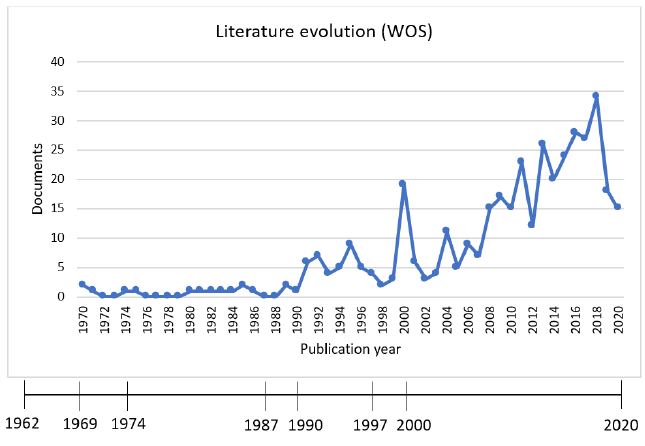
FIGURE III. Distribution of documents in Scopus and historical timeline of dyscalculia
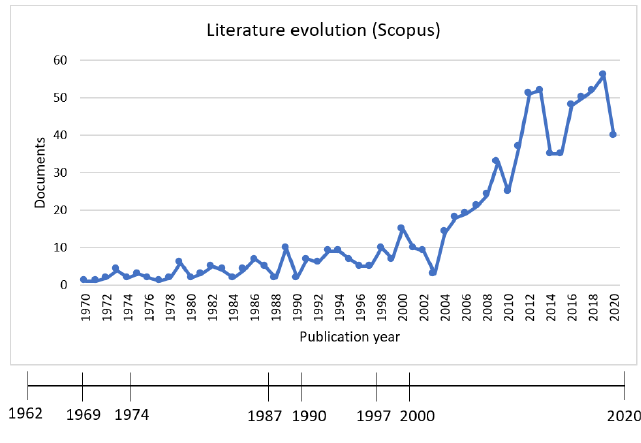
These two graphs show a trend of exponential growth in literature on dyscalculia. This rise reflects the gradual increase in interest in and attention paid to dyscalculia over the last decade, with a large influx of documents into the WoS database in 2018 and the Scopus database in 2019. However, the increase in publications has been variable, which can be seen from the repeated rise and fall in the number of documents throughout the years. One can see how various events on the timeline coincide with periodic moments of increase in research on dyscalculia as, over the past 30 years, there have been various momentary boosts in incentive for these scientific publications. From 1990 on, for example, the number of studies from a neurological standpoint increased rapidly due to the increased interest in MRIs use in studies on brain disorders. These studies revealed how dyscalculia is affected by poor coordination between one or more parts of the brain responsible for basic calculations (Sing, 2018). At the end of the 90s, different studies on genetic predisposition to dyscalculia can be observed, highlighting hereditary risk as one of the causes behind this disorder (Shaley, 2004). Moreover, in the last 25 years different programs and digital tools have been developed for the detection, diagnosis, and intervention for dyscalculia (Drigas et al., 2016), encouraged by the growing use of TICs in the education of students with LDs (Reigosa-Crespo et al., 2020).
On the other hand, keeping in mind this study’s objective of analyzing the volume of scientific literature on dyscalculia, different searches were carried out using the terms: “dyslexia” (d*slexia), “TDAH” (ADHD), aphasia (a*asia). This served to compare the volume of literature on dyscalculia to that of other LDs or disorders. This search was done in the Scopus database using the same parameters as those used with the term dyscalculia. A total of 3941 results came up for documents on dyslexia, 11214 on ADHD, and 14479 on aphasia, compared to only 781 for dyscalculia. This data can be seen in the graph on the left (Figure IV) and is accompanied by a second graph on the right, which specifically compares dyslexia to dyscalculia. As one can observe, the first graph shows how the number of scientific publications on dyscalculia is very low as compared to those of other LDs or disorders, a trend that occurs even when comparing just dyslexia to dyscalculia, despite having a different growth factor and different starting points. In fact, in the case of dyscalculia, the ascending trend of publications commented on earlier is almost indiscernible when next to the corresponding evolution of other LDs or disorders.
FIGURE IV. Comparison of the volume of literature in Scopus
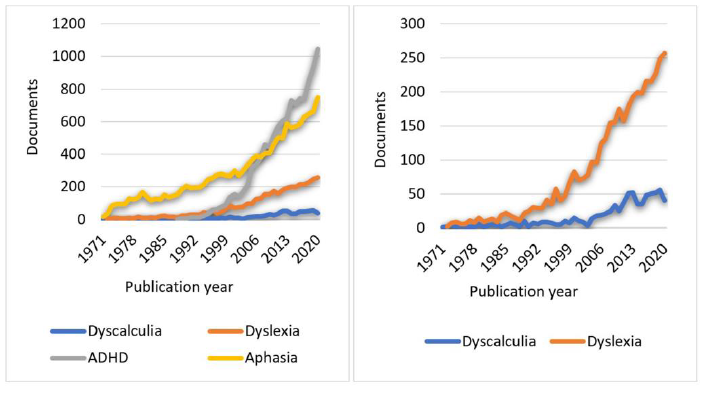
Analysis of bibliographic coupling of countries
In order to observe the distribution of publications as a function of the country of origin, a bibliographic coupling of countries was carried out. Figures V and VI show the density map visualization of the analysis. This analysis included only the countries with 10 or more associated publications, which reduced the sample to 13 countries out of the 52 found in WoS and 21 of 85 in Scopus.
FIGURE V. Density map visualization of the bibliographic country coupling analysis in WoS

FIGURE VI. Density map visualization of the bibliographic country coupling analysis in Scopus
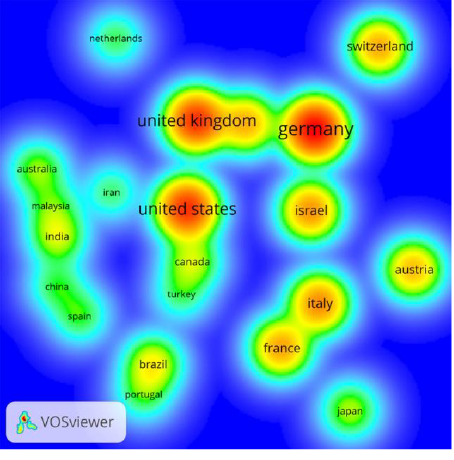
In both WoS and Scopus, the five countries with the most publications on dyscalculia in descending order are Germany, the United Kingdom, the United States, Italy, and Israel. The first three countries were to be expected since they are major world powers with expansive territories and large populations. These countries house important, influential institutions and centers with powerful research groups who publish their findings in English (English being the native language of two of them). Furthermore, in line with what has been previously mentioned, the first publications on dyscalculia appeared in these countries, making their studies the foundation for research thereafter. The fact that the third and fourth countries with the most publications on dyscalculia are Italy and Israel is more surprising. These countries have fairly disparate profiles compared to the first three countries and fall closer to the Spanish profile.
Source citation analysis
With the objective of getting to know the bibliographic sources that have the most publications on dyscalculia, an analysis of the source citations was also carried out. Figures VII and VIII show density visualization maps of the results of this analysis as a function of the relative weight of the documents. Sources with at least 10 publications were included. In WoS there were 6 sources retrieved out of 182 total, while in Scopus there were 9 out of 408.
FIGURE VII. Density map visualization of the source citation analysis in WoS
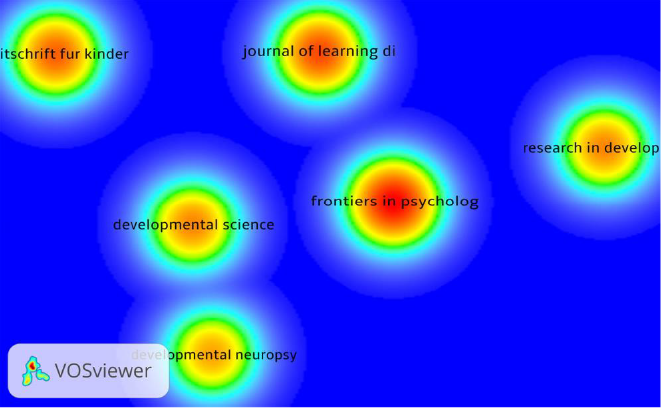
FIGURE VIII. Density map visualization of the source citation analysis in Scopus
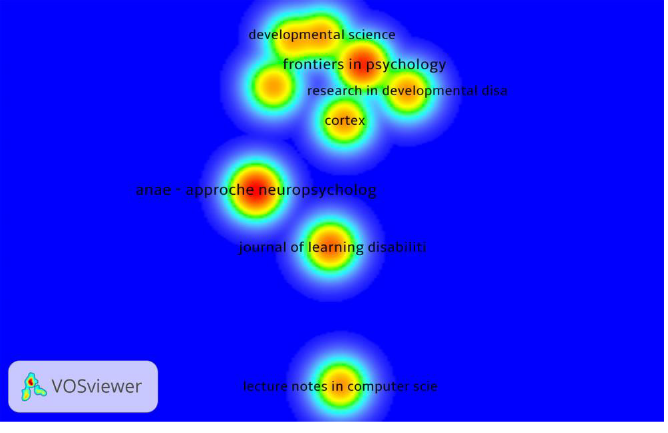
This analysis clearly shows a link between the frequency of publications on dyscalculia and the field of Psychology (Frontiers in Psychology, Developmental Science, Developmental Neuropsychology, Cortex, Neuropsychologia…). This is partially due to the fact that, since the creation of the International Group for the Psychology of Mathematics Education in 1976, psychology has become one of the most important perspectives for the research on and interpretation/analysis of mathematics education (Coessens et al., 2013). A closer look at the characteristics of the interventions into dyscalculia, as collected and analyzed by Chodura et al. (2015) as well as Monei and Pedro (2017), shows them to be predominantly clinical, outnumbering classroom interventions and other aspects of action-research.
Word co-occurrence analysis
Through word co-occurrence, the following analysis focused on identifying the main lines of research and the topics most frequently addressed in relation to dyscalculia in scientific literature. Figures IX and X show network visualization maps of said analysis which only included terms that appeared 10 times or more in the publications. Using this criterion, 54 terms came up in the WoS database. However, the number dropped to 47 after excluding word duplicates or words that only referred to the methodology used, the country in which the study was carried out, or technical issues regarding participants. On the other hand, 199 terms came up in Scopus, which decreased to 145 after similar data cleaning.
FIGURE IX. Network map visualization of word co-occurrence analysis in WoS
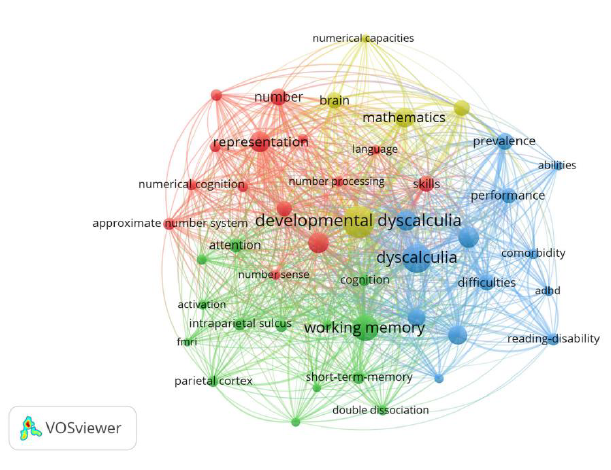
FIGURE X.. Network map visualization of word co-occurrence analysis in Scopus
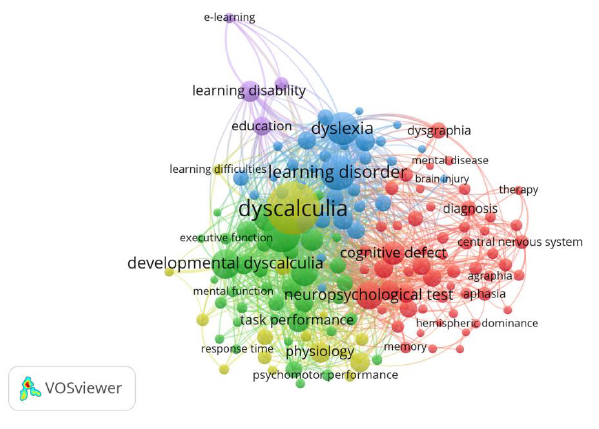
As one can see from the maps generated, the results of the WoS database search turn out to be grouped into the following four categories or clusters. For each cluster, the five most frequent terms are listed below in order of greatest occurrence to least.
- Cluster 1 (red): individual-differences, representation, number, skills, magnitude, approximate number system.
- Cluster 2 (green): Working memory, attention, short term memory, intraparietal sulcus, cognition.
- Cluster 3 (blue): Dyscalculia, dyslexia, disability, learning disabilities, deficits.
- Cluster 4 (yellow): Developmental dyscalculia, mathematics, achievement, brain, numerical capacities.
From these groups one can determine the following main lines of research on dyscalculia as those that focus on: identification and classification of signs and symptoms and of the disorder (Cluster 1, C1), the analysis of dyscalculia from a neurocognitive perspective (C2), the establishment of dyscalculia’s comorbidity with other learning disorders as well as its prevalence (C3), and, lastly, to a lesser degree, the analysis of dyscalculia’s impact on mathematics performance for those students suffering from the disorder (C4).
On the other hand, five categories, not four, were generated from the Scopus database:
- Cluster 1 (red): Neuropsychological test, magnetic resonance imaging, cognitive defect, cognition disorders, psychological aspect.
- Cluster 2 (green): Mathematics, developmental dyscalculia, arithmetic, cognition, developmental disorder.
- Cluster 3 (blue): Learning disorder, dyslexia, calculation, attention deficit disorder, comorbidity.
- Cluster 4 (yellow): Dyscalculia, physiology, pathophysiology, psychology, mathematical concepts.
- Cluster 5 (purple): Learning disability, education, teaching, e-learning.
In this case, the main lines of research correspond to the following clusters: the study of the neurological basis of dyscalculia (C1), the understanding of dyscalculia from a cognitive perspective (C2), the comorbidity of dyscalculia with other learning disorders and its prevalence (C3), the identification of signs and symptoms of dyscalculia (C4), and, lastly but also to a lesser degree, the characteristics of the most appropriate teaching methods practiced with students suffering from the disorder (C5).
Publications citation analysis
The last analysis focused on finding the most relevant publications within the scientific field of dyscalculia through a citation analysis of publications, which could be a jumping off point for a systematic review/revision of the literature that is not discussed in-depth here. For this purpose, an analysis of those documents with at least 100 citations has been included, which has lead to the selection of 28 publications of 391 found in WoS and 50 out of 781 in Scopus. Figurers XI and XII show the network visualization maps of this analysis.
FIGURE XI. Network map visualization of publications citation analysis in WoS
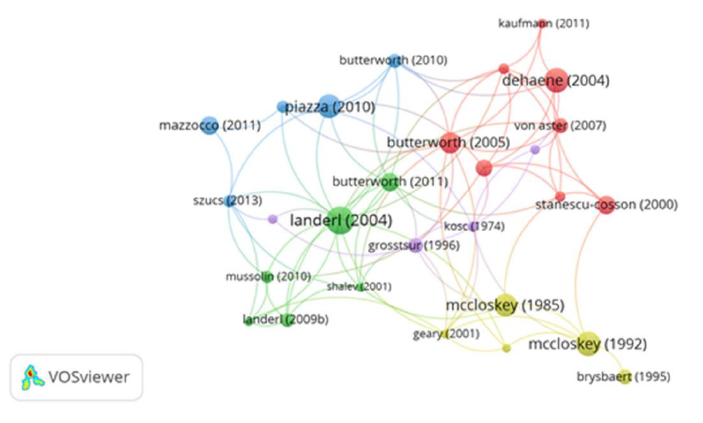
FIGURE XII. Network map visualization of publications citation analysis in Scopus

Taking into account the clusters of publications shown in these maps, different criterion for grouping can be interpreted. In some instances, the publications have been grouped together because they share an author. This is the case of the yellow Scopus cluster (Figure XII) whose publications share Karin Landerl as an author. In other clusters, the publications are connected by the perspective from which dyscalculia is studied. For example, the publications in the blue cluster share a mostly neurological approach. Nevertheless, some resulting cluster formation does not coincide with the term co-occurrence analysis. Therefore, if a first systematic review of the literature is effectuated, classification of documents by subject should be carried out deductively.
Discussion and conclusions
In etymological terms, research of this type consists of following traces of the past, like clues, for the advancement of knowledge. When this is done from a bibliometric perspective, the variables examined come from bibliographic sources, which, in and of themselves, are not enough to draw conclusions if they are not organized and presented in a way that facilitates the understanding of their evolution, the identification of patterns and trends, as well as the ability to establish connections and detect lagoons of information which could give way to a possible line of investigation towards the attainment of objectives that result in the finding answers to questions proposed in the scientific community about one particular topic. In this way, the present study, whose results have been described and examined above, helps verify with evidence hypotheses that had come up naturally from previous lectures and informal conversations with students suffering from dyscalculia, their families, teachers, as well as professionals who deal with educational orientation and provide psychopedagogical support. With this study, ideas described by Torresi (2018) and Haberstroh and Schulte-Körne (2019) on how there is a shortage of scientific literature on dyscalculia, have been confirmed, although, on the other hand, there has been a marked surge in interest in this disorder in the last decades. This study also corroborates the findings of Arroyo (2018), which indicate that dyscalculia continues to be relatively unknown on a global educational scale despite the fact that concern for mathematical literacy has constantly been on the rise, not only politically but also socially and in the area of research and investigation. It seems contradictory that more studies have not been launched on dyscalculia in countries like Spain, where the TIMSS and PISA reports show an alarming percent of students at low levels when compared to other countries with high quality math education like Finland, Estonia, and Singapore, among others.
The analysis of bibliographic coupling of countries has raised questions as to why Spain is not at the top of the list of counties that have published more frequently on dyscalculia, despite the large concern for attention to those who have SLDs. Regarding the fourth and fifth position, Israel’s strong educational integration policy stands out as well as its consolidated effort to provide services for and research into the SLDs (Al-Yagon and Margalit, 2016). On the other hand, in the case of comparing Italy and Spain, one must take into account the two most important differences between their scientific publications on dyscalculia as pointed out by Cottone (2017). The first is the fact that Italy has chosen English as the main language of communication in research on dyscalculia, whereas Spain uses Spanish, a language with less scientific diffusion in the databases used for the present study. This leads to the second difference, which is the fact that Italian researchers have published most of their articles in European or American journals, while Spanish researchers have tended to publish in Spanish or Latin-American journals. In fact, the presence of Spanish journals in the Social Science sections of WoS and Scopus is small compared to other countries despite a significant increase in the last decade (Somoza et al., 2017). Thus, it is necessary for Spanish researchers to increase production in international journals so that publications achieve wider dissemination while keeping up production Spanish and Latin-American journals (Ruiz-Corbella, et al., 2014). Lastly, one of the influential factors behind the absence of Spain among countries with the most publications on dyscalculia is the small amount of research found on the impact of integration and educational inclusion in the fields of Psychology and Mathematics Education. As such, the lines of research in Psychology center on Social Psychology (Agudelo et al., 2003), while the lines of research in Mathematics Education focus on Mathematic curriculum design, development and evaluation, as well as teacher training and theoretical development in the discipline itself (Rico, 2000).
Upon observation, the results of the term co-occurrence analysis are relatively easy to interpret. The clusters and cluster size as well as the nodes that make up the clusters show that most lines of research in dyscalculia follow psychological and neurocognitive approaches. Furthermore, they center fundamentally on diagnosis and are not commonly oriented to treatment design, educational attention, or educational intervention. If one focuses on the analysis of source citation, there seems to be a predominant connection between dyscalculia and Psychology. Regarding this observation, it must be pointed out that dyscalculia should not be limited only to Psychological approaches given that the recognition and diagnosis of a problem is useless if one cannot propose methods to prevent and limit its negative effects. The present bibliometric analysis has helped prove the distance between basic diagnostic research and the reality in the classroom concerning dyscalculia. Consequently, it would be important to carry out qualitative research on dyscalculia including action-research design, and research-based design and case study design, among others. All studies have the ability to contribute to the design and validation of educational intervention programs, which, in turn, encourage well-rounded inclusion of students with dyscalculia in the math classroom, helping to offer math re-educational protocol for students when necessary, especially in cases of late diagnosis. The focus should be on eliminating barriers to math learning with personalized educational design that molds to differences between individuals and promotes awareness of the heterogeneous profiles of students with dyscalculia. This is in line with Muntaner (2019) and Trillo and Trillo (2020), who affirm the need to develop an inclusive educational model in the classroom through the presence participation, and progression of children with special educational needs in the regular classroom.
The present study has limitations inherent in the methodological design as well as the tools used. Limitations fundamentally include the method of measurement, and thus, the ability to distinguish between quality and quantity upon limiting the searches in both databases and the procedure’s inability to detect literatura gris, as pointed out by Paez (2017). In any case, despite a range of limitations or weaknesses, the authors of this study consider the analysis carried out to have reached its objective and that the results obtained do, in fact, highlight trends, evolutions, clusters and mark possible future lines of research that could contribute to the advancement of research on dyscalculia. As such, the authors recommend further, complimentary studies that can help lessen the afore mentioned limitations and those related to in-depth, systematic revision of scientific literature on dyscalculia, based on, for example, the results of the current line study of the present authors. A new revision would help identify, among other things, the current state of knowledge on this disorder and what information is needed for the future.
In conclusion, the current authors deem it necessary to stimulate and execute more studies focused on the design and evaluation of dyscalculia intervention programs that would help math (re)education programs to be more efficient in the classroom of students suffering from this disorder. Said projects must, overall, correspond to basic principles of inclusive education and, in particular, incorporate and guaranty the presence, participation, and progress of students with dyscalculia.
We hope that visualizing the current state of the situation of research on dyscalculia, as this study does, helps stimulate the development of new lines of research that will lead to the correction of what we observe to be deficiencies in the present time, as expressed before, so that no one, despite having dyscalculia, is left behind in mathematics.
References
Adam, T., & Tatnall, A. (2008). Using ICT to improve the education of students with learning disabilities. In M. Kendall & B. Samways (Eds.), Learning to live in the knowledge society (pp. 63-70). Springer. https://doi.org/10.1007/978-0-387-09729-9_8
Agudelo, D., Bretón-López, J., Ortiz-Recio, G., Poveda-Vera, J., Teva, I., Valor-Segura, I., & Vico, C. (2003). Análisis de la productividad científica de la Psicología española a través de las tesis doctorales. Psicothema, 15(4), 595-609.
Al-Yagon, M., & Margalit, M. (2016). Specific learning disabilities: The Israeli perspective. Learning Disabilities: A Contemporary Journal, 14(1), 39-51.
Arroyo, J. (2018, November 16). Decálogo para explicar la discalculia. Mejor Educados. Recuperado de https://bit.ly/3aMGgvQ
Asociación Americana de Psiquiatría (2013). Guía de consulta de los criterios diagnósticos del DSM-5. Asociación Americana de Psiquiatría.
Butterworth, B., Varma, S., & Laurillard, D. (2011). Dyscalculia: From brain to education. Science, 332, 1049-1053. https://doi.org/10.1126/science.1201536
Chodura, S., Kuhn, J.T., & Holling, H. (2015). Interventions for children with mathematical difficulties: A meta-analysis. Zeitschrift für Psychologie, 223(2), 129-144. https://doi.org/10.1027/2151-2604/a000211
Coessens, K., François K., & Bendegem, J.P.V. (2013). Mirror Neuron, Mirror Neuron in the Brain, Who’s the Cleverst in Your Reign? From the Attraction of Psychology to the Discovery of the Social. In P. Smeyers & M. Depaepe (Eds.), Educational Research: The Attraction of Psychology (pp. 91-104). Springer. https://doi.org/10.1007/978-94-007-5038-8_6
Congreso de los Diputados. Proyecto de Ley Orgánica por la que se modifica la Ley Orgánica 2/2006, de 3 de mayo, de Educación. Boletín Oficial de las Cortes Generales, 25 de noviembre de 2020, 113, 3-79.
Coronado-Hijón, A. (2008). Dificultades de aprendizaje de las matemáticas: Conceptos básicos y diagnóstico. Revista de humanidades, (15), 237-270.
Cottone, A. (2017). La discalculia evolutiva: Estudio comparativo de la producción científica en España e Italia [Doctoral dissertation, Universidad de Extremadura]. Redined. https://bit.ly/3nS9PzR
Drigas, A.S., Pappas, M.A., & Lytras, M. (2016). Emerging Technologies for ICT based Education for Dyscalculia: Implications for Computer Engineering Education. International journal of engineering education, 32(4), 1604-1610.
Estévez, N., Castro, D., & Reigosa, V. (2008). Bases biológicas de la discalculia del desarrollo. Revista cubana genética comunitaria, 2(3), 14-19.
Fonseca, F., López, P.Á., & Massagué, L. (2019). La discalculia un trastorno específico del aprendizaje de la matemática. Roca: Revista Científico-Educaciones de la provincia de Granma, 15(1), 212-224.
García, J., & González, D. (2001). Dificultades de aprendizaje e intervención psicopedagógica. Concepto, evaluación y tratamiento (Vol. I.). CEOS.
Haberstroh, S., & Schulte-Körne, G. (2019). The diagnosis and treatment of dyscalculia. Deutsches Ärzteblatt International, 116(7), 107-114. https://doi.org/10.3238/arztebl.2019.0107
Hallahan, D.P., & Mercer, C.D. (2002). Learning disabilities: Historical perspectives. In R. Bradley, L. Danielson, & D.P. Hallahan (Eds.), Identification of learning disabilities: Research to practice (pp. 1-67). Lawrence Erlbaum. https://doi.org/10.4324/9781410606297
Junquero, A.B. (2019). Estudi sobre l’origen de la discalcúlia: Reflexions sobre possibles vies de correcció a l’aula. Temps d’Educació, (56), 183-205. http://dx.doi.org/10.1344/TE2019.56.11
Kaufmann, L., Mazzocco, M.M., Dowker, A., von Aster, M., Göbel, S.M., Grabner, R.H., Henik, A., Jordan, N.C., Karmiloff-Smith, A.D., Kucian, K., Rubinsten, O., Szucs, D., Shalev, R., & Nuerk, H.C. (2013). Dyscalculia from a developmental and differential perspective. Frontiers in psychology, 4(516). https://doi.org/10.3389/fpsyg.2013.00516
Kirk, S.A., & Bateman, B. (1962). Diagnosis and remediation of learning disabilities. Exceptional Children, 29(2), 73-78. https://doi.org/10.1177/001440296202900204
Kosc, L. (1974). Developmental dyscalculia. Journal of learning disabilities, 7(3), 164-177. https://doi.org/10.1177/002221947400700309
May, Y.S., & Ahmad, N.A. (2020). A view on theories and models in the study of dyscalculia. International Journal of Academic Research in Business and Social Sciences, 9(3), 128-137. http://dx.doi.org/10.6007/IJARPED/v9-i3/8257
Ministerio de Educación, Cultura y Deporte. Ley Orgánica 1/1990, de 3 de octubre, de ordenación general del sistema educativo (LOGSE). Boletín Oficial del Estado, 4 de octubre de 1990, 238, 28927-28942.
Ministerio de Educación, Cultura y Deporte. Ley Orgánica 2/2006, de 3 de mayo, de educación (LOE). Boletín Oficial del Estado, 4 de mayo de 2006, 106, 17158-17207.
Ministerio de Educación, Cultura y Deporte. Ley Orgánica 8/2013, de 9 de diciembre, de mejora de la calidad de la educación (LOMCE). Boletín Oficial del Estado, 10 de diciembre de 2013, 295, 97858-97921.
Monei, T., & Pedro, A. (2017). A systematic review of interventions for children presenting with dyscalculia in primary schools. Educational psychology in practice, 33(3), 277-293. https://doi.org/10.1080/02667363.2017.1289076
Muntaner, J.J. (2010). De la integración a la inclusión: un nuevo modelo educativo. In Arnaiz, P., Hurtado, M.D., & Soto, F.J. (Coords.) 25 años de integración escolar en España: Tecnología e inclusión en el ámbito educativo, laboral y comunitario. Consejería de Educación, Formación y Empleo.
National Institutes of Health. (2019). Learning Disabilities Research Centers (LDRC). Consortium. Retrieved from https://bit.ly/2McAOrZ
Organización Mundial de la Salud (2020). CIE-11. Clasificación Internacional de Enfermedades, 11.a revisión. Retrieved from https://bit.ly/38AsmKr
Paez, A. (2017). Gray literature: An important resource in systematic reviews. Journal of Evidence-Based Medicine, 10(3), 233-240. https://doi.org/10.1111/jebm.12266
Pérez-Escoda, A. (2017, February 9). WOS y Scopus: Los grandes aliados de todo investigador. Escuela de autores. Revista Comunicar. https://doi.org/10.3916/escuela-de-autores-031
Perianes-Rodriguez, A., Waltman, L., & Van Eck, N.J. (2016). Constructing bibliometric networks: A comparison between full and fractional counting. Journal of informetrics, 10(4), 1178-1195. https://doi.org/10.1016/j.joi.2016.10.006
Reigosa-Crespo, V., Castro-Cañizares, D., Estévez-Pérez, N., Santos, E., Torres, R., Mosquera, R., Álvarez, A., Recio, B., González, E., Amor, V., Ontivero, M., & Valdés-Sosa, M. (2020). Numerical skills and dyscalculia. From basic research to practice in Cuba. Studies in Psychology, 41(2), 373-403. https://doi.org/10.1080/02109395.2020.1749502
Rico, L. (2000). Universidad, investigación y didáctica de la matemática en España. Números. Revista de didáctica de las matemáticas, (43-44), 409-412.
Ruiz-Corbella, M., Galán, A., & Diestro, A. (2014). Las revistas científicas de Educación en España: evolución y perspectivas de futuro. RELIEVE, 20(2). https://doi.org/10.7203/relieve.20.2.4361
Sans, A., Boix, C., Colomé, R., López-Sala, A., & Sanguinetti, A. (2012). Trastornos del aprendizaje. Pediatría integral, 16(9), 691-699.
Shalev, R.S. (2004). Developmental dyscalculia. Journal of child neurology, 19(10), 765-771. https://doi.org/10.1177/08830738040190100601
Shneider, A.M. (2009). Four stages of a scientific discipline: Four types of scientists. Trends in Biochemical Sciences, 34(5), 217-223. https://doi.org/10.1016/j.tibs.2009.02.002
Singh, M. (2018, October 16). History of dyscalculia. Number Dyslexia. Retrieved from https://bit.ly/37TwpTf
Somoza, M., Guallar, J., Rodríguez Gairín, J. M., & Abadal, E. (2017). Presencia de revistas españolas en bases de datos internacionales. In E. Abadal (Ed.), Revistas científicas: situación actual y retos de futuro (pp. 161-178). Universitat de Barcelona.
Spinak, E. (1998). Indicadores cienciometricos. Ciência da informação, 27(2), 144-148. https://dx.doi.org/10.1590/S0100-19651998000200006
Torresi, S. (2018). Discalculia del Desarrollo (DD). Revista de Psicopedagogía, 35(108), 348-356.
Trillo, F., & Trillo, J.R. (2021). Inclusión del alumnado con dificultades específicas de aprendizaje. In T. Sola, S. Alonso-García, M.G. Fernández & J.C. de la Cruz (Eds.), Estudios sobre innovación e investigación educativa (pp. 485-494). Dykinson.
Van Eck, N.J., & Waltman, L. (2010). Software survey: VOSviewer, a computer program for bibliometric mapping. Scientometrics, 84(2), 523-538. https://doi.org/10.1007/s11192-009-0146-3
Van Leeuwen, T. (2004). Descriptive versus evaluative bibliometrics. Monitoring and assessing of National R&D Systems. In H.F., Moed, W., Glänzel, & U., Scmoch (Eds.), Handbook of quantitative science and technology (pp. 373-388). Kluwer Academic Publishers. https://doi.org/10.1007/1-4020-2755-9
Contact address: Estefanía Espina. Universidad de Valladolid, Departamento Didáctica de las Ciencias Experimentales, Sociales y de la Matemática. Paseo de Belén, 1, 47011 Valladolid. E-mail: estefania.espina@uva.es
1 Our research was made possibly through the financial support of the Ministry of Education of Castilla y León and through other aids focused on the hiring of predoctoral researchers, co-financed by the European Social Fund.